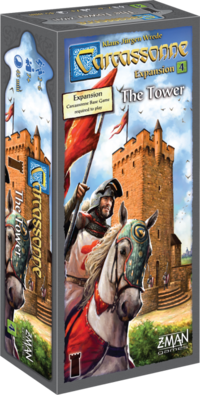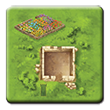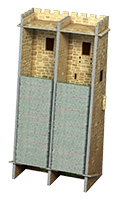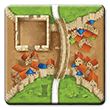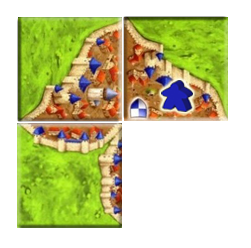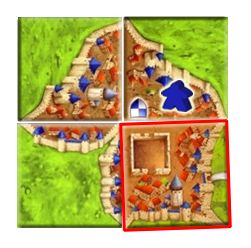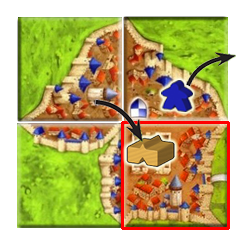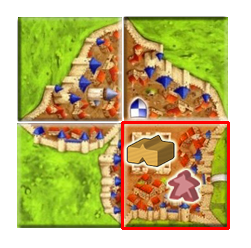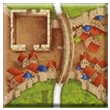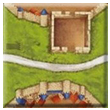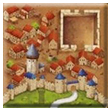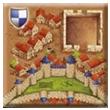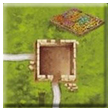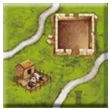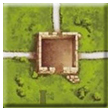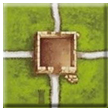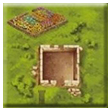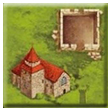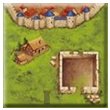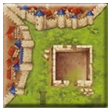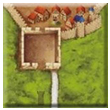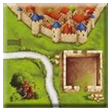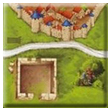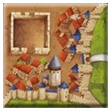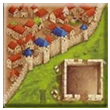The Tower
 |
You are reading the rules for this tile design. |
 | Read the following rules if your tiles look like this. |
| If your tiles have a different design, then choose a game from Spin-offs. |  |
General info and comments
The Tower was released for the New Edition by Hans im Glück in 2016. The 1st. Edition was originally released in 2006. The tiles of the first German editions had no expansion symbol.
This is the fourth major expansion for Carcassonne and introduces a new aspect to the game. With this expansion you can build high towers from which you can capture opposing players' meeples, and hold them for ransom or wait for a one-for-one exchange.
This expansion contains 18 tiles that represent city segments, road segments and cloisters in new configurations plus the addition of tower foundations which will help create much more than a beautiful landscape.
New features are:
- Towers, that allow players to capture meeples from the playing area within a given range.
Contents
- 18 Land tiles with a tower foundation
- 30 Tower floors (in one neutral color)
- 1 Tile Tower as tile dispenser
Do not disassemble the Tile Tower when storing the game. During the game, you may take your tiles from the top or the bottom of the tower. However, in order to avoid causing the tower and the tiles to fall, we recommend taking them from the top, especially when there are only a few tiles left in the tower.
Capacity of the Tile Tower is exactly 100 tiles per column without squeezing anything + 8 tiles on top of each column of the Tile Tower. Potentially it can hold 216 tiles. Keep in mind though that not all tiles have the same thickness and there is also some variation in the dimensions of individual towers!
New land tiles
The new Land tiles are played just like any other tile. Tower foundations are the only new element introduced on these tiles. There is also a special case, shown below.
Rules
Preparation
Shuffle the new Land tiles with the others, and put them all face down in the Tile Tower. You can put the tiles in the left side, the right side, or both: this has no impact on gameplay. Place the Tile Tower within easy reach of all players.
Then, depending on the number of players, give each player the corresponding number of tower floors.
Number of players Tower floors 2 players 3 players 4 players 5 players 6 players
Players place these in their supply (with their meeples). Return any unused tower floors to the box.
The tower
1. Placing a tile
Tower foundation tiles are placed exactly like those in the base game.
2. Placing a meeple or a tower floor
After placing your tile, you now have 4 actions to choose from: [1]
- You may place one of your meeples on the just-placed tile (following the normal rules).
3 new actions:
- A Place one of your tower floors on a tower foundation space on any placed tile.
- B Place one of your tower floors to any open tower on the board.
- C Place one of your meeples on any open tower. This closes the tower. [2]
PLACING A TOWER FLOOR AND CAPTURING A MEEPLE
Whenever you place a tower floor, you may immediately take 1 meeple off the board; it can belong to any player, including yourself. The captured meeple is placed in front of you. When "capturing" your own meeple, return it to your supply.
The level where you placed your tower floor determines the tiles from which you may capture a meeple. You may always choose the tile on which you placed your tower floor. From there, for each floor in the tower, you can reach one tile in each of the 4 directions. For example, if the tower floor you placed is the first level, you have access to 5 tiles (see example below).
Placing the second level in a tower would give you access to 9 tiles from which to capture a meeple (see example below).
Consequently, each floor added to a tower extends its reach by 4 tiles (one tile in each direction). [3] This reach goes beyond empty spaces on the board and over all towers. There can be any number of floors in an open tower.
![]() Question: Can a shorter tower capture the meeple from a taller tower, or does the tower need to be equal or greater in height?
Question: Can a shorter tower capture the meeple from a taller tower, or does the tower need to be equal or greater in height?
Answer: The height of the tower only determines the range of the ‘attack’ and has no other function.
PLACING A MEEPLE ON A TOWER
When you place one of your meeples on a tower, [4] that tower is now closed and no more floors may be added to it. [5] Your meeple stays there until the end of the game (you may not take it back), or until it is captured (which you may do yourself). Players will usually take this action to protect their meeples on the board.EXCHANGING PRISONERS
Whenever you and another player have a meeple belonging to the other, you exchange them immediately. [6] The meeples are thus returned to their respective owners. If you or the other player have more than one prisoner belonging to the other, the owner chooses which prisoner to take back.BUYING BACK PRISONERS
In addition, during your turn you may buy back one of your captured meeples. Pay the player who captured it 3 points (you reduce your score and increase theirs).
If you do not have at least 3 points, you may not buy back a meeple (this would drop your score below 0, which is not allowed). You may use a meeple in the same turn you buy it back.
3. Scoring a feature
The Tower does not affect scoring.
Other expansions
Many figures now exist within the world of Carcassonne, and some questions may arise when you play with The Tower expansion. Here is a list of the various figures and the actions you may and may not do with them.
- Normal meeple (
 Base Game)
Base Game) - Large meeple (
 Exp. 1 - Inns & Cathedrals)
Exp. 1 - Inns & Cathedrals) - Ringmaster, even if is a bit wobbly (
 Exp. 10 - Under the Big Top)
Exp. 10 - Under the Big Top) - Guard meeple (
 Exp. 11 - Ghosts, Castles & Cemeteries) [7]
Exp. 11 - Ghosts, Castles & Cemeteries) [7] - Phantom (
 The Phantom)
The Phantom)
![]() Figures you may NOT place on a tower:
Figures you may NOT place on a tower:
- Abbot (Base Game -
 The Abbot)
The Abbot) - Pig (
 Exp. 2 - Traders & Builders)
Exp. 2 - Traders & Builders) - Builder (
 Exp. 2 - Traders & Builders)
Exp. 2 - Traders & Builders) - Wagon (
 Exp. 5 - Abbey & Mayor)
Exp. 5 - Abbey & Mayor) - Mayor (
 Exp. 5 - Abbey & Mayor)
Exp. 5 - Abbey & Mayor) - Barn (
 Exp. 5 - Abbey & Mayor)
Exp. 5 - Abbey & Mayor) - Shepherd (
 Exp. 9 - Hills & Sheep)
Exp. 9 - Hills & Sheep)
![]() Figures you may capture from the board (including your own):
Figures you may capture from the board (including your own):
- Normal meeple (
 Base Game)
Base Game) - Abbot (Base Game -
 The Abbot)
The Abbot) - Large meeple (
 Exp. 1 - Inns & Cathedrals)
Exp. 1 - Inns & Cathedrals) - Meeple on a tower (
 Exp. 4 - The Tower)
Exp. 4 - The Tower) - Wagon (
 Exp. 5 - Abbey & Mayor)
Exp. 5 - Abbey & Mayor) - Mayor (
 Exp. 5 - Abbey & Mayor)
Exp. 5 - Abbey & Mayor) - Meeple on bridge (
 Exp. 8 - Bridges, Castles & Bazaars)
Exp. 8 - Bridges, Castles & Bazaars) - Ringmaster (
 Exp. 10 - Under the Big Top)
Exp. 10 - Under the Big Top) - Guard meeple (
 Exp. 11 - Ghosts, Castles & Cemeteries)
Exp. 11 - Ghosts, Castles & Cemeteries) - Phantom (
 The Phantom)
The Phantom)
Buying back captured figures always costs 3 points, regardless of which type of figure is being bought back.
![]() Figures you may NOT capture from the board:
Figures you may NOT capture from the board:
- Pig (
 Exp. 2 - Traders & Builders)
Exp. 2 - Traders & Builders) - Builder (
 Exp. 2 - Traders & Builders)
Exp. 2 - Traders & Builders) - Barn (
 Exp. 5 - Abbey & Mayor)
Exp. 5 - Abbey & Mayor) - Meeple in the city of Carcassonne (
 Exp. 6 - Count, King & Robber)
Exp. 6 - Count, King & Robber) - Meeple in a castle (
 Exp. 8 - Bridges, Castles & Bazaars)
Exp. 8 - Bridges, Castles & Bazaars) - Shepherd (
 Exp. 9 - Hills & Sheep)
Exp. 9 - Hills & Sheep) - Meeple on a crown space of the Wheel of Fortune (
 The Wheel of Fortune)
The Wheel of Fortune) - Meeple in the city of Leipzig, due to its similarity to the city of Carcassonne (
 The Markets of Leipzig)
The Markets of Leipzig) - All neutral figures and tokens:
- Fairy (
 Exp. 3 - The Princess & the Dragon)
Exp. 3 - The Princess & the Dragon) - Dragon (
 Exp. 3 - The Princess & the Dragon)
Exp. 3 - The Princess & the Dragon) - Count (
 Exp. 6 - Count, King & Robber)
Exp. 6 - Count, King & Robber) - King token (
 Exp. 6 - Count, King & Robber)
Exp. 6 - Count, King & Robber) - Robber Baron token (
 Exp. 6 - Count, King & Robber)
Exp. 6 - Count, King & Robber) - Bridge (
 Exp. 8 - Bridges, Castles & Bazaars)
Exp. 8 - Bridges, Castles & Bazaars) - Castle token (
 Exp. 8 - Bridges, Castles & Bazaars)
Exp. 8 - Bridges, Castles & Bazaars) - Sheep token (
 Exp. 9 - Hills & Sheep)
Exp. 9 - Hills & Sheep) - Big Top (
 Exp. 10 - Under the Big Top)
Exp. 10 - Under the Big Top) - Animal tokens (
 Exp. 10 - Under the Big Top)
Exp. 10 - Under the Big Top) - Ghost (
 Exp. 11 - Ghosts, Castles & Cemeteries)
Exp. 11 - Ghosts, Castles & Cemeteries) - Big Pink Pig (
 The Wheel of Fortune)
The Wheel of Fortune) - Ferry (
 Mini #3 - The Ferries)
Mini #3 - The Ferries) - Gold ingot (
 Mini #4 - The Goldmines)
Mini #4 - The Goldmines) - Mage (
 Mini #5 - Mage & Witch)
Mini #5 - Mage & Witch) - Witch (
 Mini #5 - Mage & Witch)
Mini #5 - Mage & Witch) - Fruit tokens (
 The Fruit-Bearing Trees)
The Fruit-Bearing Trees) - Tollhouse tokens (
 The Tollkeepers)
The Tollkeepers) - Little Building tokens (
 Little Buildings)
Little Buildings) - Outbreak tokens (
 The Plague)
The Plague) - Flea token (
 The Plague)
The Plague) - Teacher (
 The School)
The School) - Tunnel tokens (
 The Tunnel)
The Tunnel)
- Fairy (
![]() Question: How often does prisoner buy-back occur in a “double turn” (e.g. just once, like fairy scoring, or twice, as part of a repeated step)?
Question: How often does prisoner buy-back occur in a “double turn” (e.g. just once, like fairy scoring, or twice, as part of a repeated step)?
Answer: It happens once per turn. The double-turn is [truly] only a single turn.
![]() Exp. 3 - The Princess & the Dragon
Exp. 3 - The Princess & the Dragon
![]() The fairy can be assigned to a meeple placed on top of a tower. The fairy would stand by the tower.
The fairy can be assigned to a meeple placed on top of a tower. The fairy would stand by the tower.
![]() The dragon CAN eat a meeple on a tower.
The dragon CAN eat a meeple on a tower.
![]() Exp. 8 - Bridges, Castles & Bazaars
Exp. 8 - Bridges, Castles & Bazaars
![]() Exp. 11 - Ghosts, Castles & Cemeteries
Exp. 11 - Ghosts, Castles & Cemeteries
![]() If a tower captures a meeple with ghosts, these ghosts will return to the general supply.
If a tower captures a meeple with ghosts, these ghosts will return to the general supply.
![]() You may place a valid meeple as first figure on an open tower and your phantom as second figure on a second open tower in the same turn.
You may place a valid meeple as first figure on an open tower and your phantom as second figure on a second open tower in the same turn.
![]() In the same turn, you may place a tower, place a tower floor (as first figure) on it, capture a meeple on an adjacent orthogonal tile (that is, range 1), and place your phantom (as second figure) on the tower tile just placed. This sequence would allow you to:
In the same turn, you may place a tower, place a tower floor (as first figure) on it, capture a meeple on an adjacent orthogonal tile (that is, range 1), and place your phantom (as second figure) on the tower tile just placed. This sequence would allow you to:
- Claim a city with your phantom after capturing the only knight in it; or
- Claim a road with your phantom after capturing the only highwayman on it.
The following examples illustrate this sequence:
House Rules
![]() Towers cannot capture over empty tiles. (Thanks to viberunner)
Towers cannot capture over empty tiles. (Thanks to viberunner)
![]() A captured meeple cannot be returned by payment of a ransom (the “Eye for an Eye” rule). (Thanks to keyofnight)
A captured meeple cannot be returned by payment of a ransom (the “Eye for an Eye” rule). (Thanks to keyofnight)
![]() A single-storey tower can only capture a meeple on its own tile. Each additional storey adds an additional tile of range in each direction – the rate of increasing range is the same as the normal rules, but the starting point is less powerful (the “No Surprises” rule). (Thanks to keyofnight)
A single-storey tower can only capture a meeple on its own tile. Each additional storey adds an additional tile of range in each direction – the rate of increasing range is the same as the normal rules, but the starting point is less powerful (the “No Surprises” rule). (Thanks to keyofnight)
![]() A tower can also capture meeples on tiles diagonal to the tower tile. The distance to the capture tile is considered to be the smallest number of horizontal and vertical moves needed to get there, so a diagonal adjacent to the tower tile is considered to be 2 tiles away. (Thanks to Yi Niu)
A tower can also capture meeples on tiles diagonal to the tower tile. The distance to the capture tile is considered to be the smallest number of horizontal and vertical moves needed to get there, so a diagonal adjacent to the tower tile is considered to be 2 tiles away. (Thanks to Yi Niu)
Tile distribution
Footnotes
For Icons explanation and licensing please visit Icons page.
- ↑
 Some printed ZMG rulebooks contain a different version of this sentence, including an additional restriction by mistake:
Some printed ZMG rulebooks contain a different version of this sentence, including an additional restriction by mistake:
"After placing a tile with a tower foundation, you may perform one of the four following actions:[...]"
The original rules by HiG do not mention that these actions require a tile with a tower foundation.
This error was corrected in the PDF version of the rules. - ↑
 A meeple cannot be placed on a tower foundation to prevent a tower being built. Only tower floors can be placed on tower foundations. The tower can only be blocked when it already exists.
A meeple cannot be placed on a tower foundation to prevent a tower being built. Only tower floors can be placed on tower foundations. The tower can only be blocked when it already exists.
- ↑
 In other words, the range of tiles in each direction away from the tower (not counting the tower tile itself) is equal to the number of tower pieces in the tower.
In other words, the range of tiles in each direction away from the tower (not counting the tower tile itself) is equal to the number of tower pieces in the tower.
- ↑
 Tower foundations and towers built on top are separate features from roads, cities and fields. Towers are not part of any of the features they stand on or "touch" (they are not part of a city or field touching them), so there is no interaction between them:
Tower foundations and towers built on top are separate features from roads, cities and fields. Towers are not part of any of the features they stand on or "touch" (they are not part of a city or field touching them), so there is no interaction between them:
- A meeple placed on a tower does not affect majority of the features touching the tower (roads, cities or fields), and therefore the meeple does not participate in their scoring.
- A meeple placed on a tower is not affected by actions involving the features touching the tower, such as, a princess symbol.
- ↑
 This is only true as long as the meeple remains on the tower – it is the meeple's presence on the tower that halts tower growth, not the act of placement. If the meeple is removed by the dragon or another tower, tower pieces can once again be added to the now-vacated tower. (11/2013)
This is only true as long as the meeple remains on the tower – it is the meeple's presence on the tower that halts tower growth, not the act of placement. If the meeple is removed by the dragon or another tower, tower pieces can once again be added to the now-vacated tower. (11/2013)
- ↑
 No negotiation is necessary or allowed. The exchange is automatic! - as clarified in the RGG edition of the
No negotiation is necessary or allowed. The exchange is automatic! - as clarified in the RGG edition of the  Big Box 1.
Big Box 1.
- ↑
 Guard meeples can be placed on top of a tower, since they represent a normal meeple with a torch that does not hinder its placement.
Guard meeples can be placed on top of a tower, since they represent a normal meeple with a torch that does not hinder its placement.
